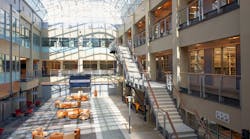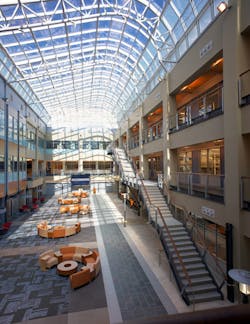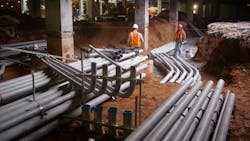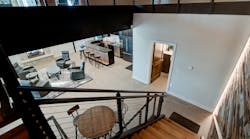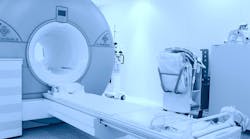Contractors are breathing new life into historic buildings in downtown Winston Salem, N.C. Located in an area once known for its thriving tobacco industry, the structures are now being repurposed for art galleries, local businesses, and even high-tech laboratories (Photo 1). This urban renewal project, which is taking place over several years, includes the development of the Wake Forest Innovation Quarter, a hub for innovation in biomedical, materials science, and biotechnology.
Formerly called the Piedmont Triad Research Park, the buildings are housed inside historic structures like existing R.J. Reynolds tobacco warehouses. The company donated the buildings to Wake Forest University, which is now renovating them for use as labs and medical buildings.
The owner hired Starr Electric Co., Inc. as the electrical contractor, Whiting-Turner Contracting Co. as the general contractor, Kibart as the electrical engineering firm, and Gaudreau, Inc. as the architect to renovate the 242,000-sq-ft historical building for Wexford Science + Technology.
The top floor of the building is dedicated to the Wake Forest Innovation Quarter team and mainly houses office space. The third and fourth floors are designed to be tenant spaces and are leased to facilities that support the labs, such as Carolina Chemical. The first and second floors of the building are specifically used for lab space (Photo 2).
Powering the research center
When the construction team arrived on site, they gutted and beamed the 70-yr-old warehouses. Starr Electric, a Greensboro, N.C.-based electrical contractor, focused on helping with the demolition to make it safe for the other trades on the project.
Next, the team worked on the underground portion of the project through concrete removal, excavation, and backfill. The electricians installed a complex underslab raceway system (Photo 3) for all the robotics equipment and electrical distribution equipment throughout the building.
In addition to installing three new 4,000A services, Starr Electric also placed two 750kW natural gas generators on the roof to save space and eliminate the need for a gas storage tank or generator yard on the limited site footprint.
The electricians installed a complete fire alarm system, which included an atrium smoke evacuation system. Once the alarm system is activated, all the doors in the building open, and the fans start exhausting air to the outside.
In addition, Starr Electric needed to install a significant amount of branch circuit wiring and cooling apparatuses to house all labs, vivarium, offices, X-ray machines, and autoclaves. For lightning protection, the contractor also constructed a ground ring around the perimeter of the roof with air terminals located on every piece of equipment. These terminals are connected to down conductors or leads that run through the building to ground rods located around the perimeter of the structure.
Illuminating the historic building
When it came to lighting the new research building, the electricians predominately installed fluorescent luminaires. But since the entire support structure was concrete, the electricians had to core drill an extremely large number of holes and install anchors to support their equipment.
“That was a big challenge to overcome,” says Brad Kennedy, senior project manager for Starr Electric. “Sixty-year-old concrete is very hard and very brittle.”
Also, to meet LEED standards, the electricians installed quite a few refurbished and historic lighting fixtures throughout the space. Some 200 of the luminaires were installed in the atrium in the center of the building. It took three electricians to install each luminaire in this area, as they had to work from a basket carrier attached to one of the structural beams holding the glass structure in place.
Unique challenges
Due to the nature of the job, the construction team faced many challenges. For example, the building had to feature a clean room environment. One half of the lower floor is an animal research testing facility, which needs to be completely sanitary and very quiet.
To meet the owner’s specifications, the workers constructed insulated partitions and a wash-down area. Because the animals are sensitive to any foreign substances, it was critical to ensure that they weren’t influenced by any outside agents. For that reason, the only access to anything above the ceiling had to be done through an access door. As a result, Starr Electric had to plan the conduit routing to coincide with access door locations.
Another challenge on the job was the aggressive construction schedule. Because a lot of work had to happen in a very short period of time, the subcontractors had to be team oriented and work well together to get the job done. Fortunately, the team had a large lay down yard, which made it very easy for the various trades to store materials for the project.
To meet the deadlines on the fast-track project, which began on Nov. 15, 2010, and ended on Dec. 2, 2011, the electricians had to work in split shifts. One crew came in from 7 a.m. to 5:30 p.m., and the other arrived at 3:30 p.m. and left at midnight, putting in a total of 170,000 man hours.
“Everyone worked 60 hours, six days a week,” Kennedy says. “It was an aggressive schedule, and we had almost 150 electricians assigned to the project. The mechanical contractor had nearly 300.”
By ramping up their labor hours, the team managed to complete the job two weeks early and win the Eagle award in the specialty contractor category from the Associated Builders and Contractors.
Through a team effort, the contractors transformed two run-down buildings into a single biotech research center for Wake Forest University. The former tobacco warehouses have now been reborn as a LEED silver-certified high-tech spot for research and development for decades to come.
Fischbach is a freelance writer based in Overland Park, Kansas. She can be reached at [email protected].
